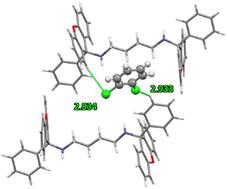当前位置:
X-MOL 学术
›
CrystEngComm
›
论文详情
Our official English website, www.x-mol.net, welcomes your
feedback! (Note: you will need to create a separate account there.)
Alternative separation strategy for o-/p-dichlorobenzene mixtures through supramolecular chemistry protocols
CrystEngComm ( IF 2.6 ) Pub Date : 2024-08-14 , DOI: 10.1039/d4ce00684d Brandon Barnardo 1 , Benita Barton 1 , Eric C. Hosten 1
CrystEngComm ( IF 2.6 ) Pub Date : 2024-08-14 , DOI: 10.1039/d4ce00684d Brandon Barnardo 1 , Benita Barton 1 , Eric C. Hosten 1
Affiliation

|
N,N′-Bis(9-phenyl-9-xanthenyl)butane-1,4-diamine (H), a compound bearing two tricyclic fused ring systems linked by means of a four carbon diamino chain, was assessed for its host ability when presented with the three dichlorobenzene (DCB) isomers by means of crystallization experiments from each one. In this manner, it was shown that H was not capable of encapsulating pDCB, whilst both oDCB and mDCB successfully formed inclusion compounds with this host compound; host : guest (H : G) ratios were 1 : 1.5 in both instances. Host crystallization experiments from binary guest mixtures involving oDCB and mDCB demonstrated that H possessed only a moderate selectivity towards oDCB (the selectivity coefficients, K, were low and ranged between 2.1 and 5.4). However, remarkably, the preference of H towards oDCB when mixed in a 40 : 60 molar ratio with pDCB was overwhelming, and 89.3% of oDCB was measured in the crystals; K was significant (12.5). Of even greater prominence was the observation that when oDCB/pDCB were mixed in 80 : 20 molar proportions, only oDCB (100.0%) was observed in the complex, and K was infinite. These results demonstrate that oDCB/pDCB (40 : 60 and 80 : 20) may be separated/purified by means of H through supramolecular chemistry strategies, this being extremely challenging to achieve by means of more conventional fraction distillations due to similarities in the physical properties of these isomers. Meaningful single crystal X-ray diffraction (SCXRD) data were only possible for H·1.5(oDCB) as the crystal quality of complex H·1.5(mDCB) was poor (owing to extreme twinning). This complex (H·1.5(oDCB)) was also subjected to Hirshfeld surface analyses, while both complexes were analysed by means of thermoanalytical experiments as well: H·1.5(oDCB) experienced a multi-stepped guest release process whilst the guest in H·1.5(mDCB) escaped from the crystals of the complex in a single step. Finally, the thermal stability of the complex with preferred oDCB was higher than that with less favoured mDCB.
中文翻译:

通过超分子化学方案分离邻/对二氯苯混合物的替代策略
N , N '-双(9-苯基-9-呫吨基)丁烷-1,4-二胺 ( H ) 是一种带有通过四碳二氨基链连接的两个三环稠合环系统的化合物,评估了其宿主能力通过对每种异构体进行结晶实验,得到三种二氯苯 (DCB) 异构体。以这种方式,表明H不能包封p DCB,而o DCB和m DCB都成功地与该主体化合物形成包合物;在这两种情况下,主人:客人(H:G)比率均为 1:1.5。涉及o DCB 和m DCB 的二元客体混合物的主体结晶实验表明, H对o DCB 仅具有中等选择性(选择性系数K较低,范围在 2.1 和 5.4 之间)。然而,值得注意的是,当以 40:60 摩尔比与p DCB 混合时, H对o DCB 的偏好是压倒性的,并且在晶体中测量到了 89.3% 的o DCB; K显着 (12.5)。更突出的是观察到当o DCB/ p DCB以80:20摩尔比例混合时,在络合物中仅观察到o DCB (100.0%),且K为无穷大。 这些结果表明, o DCB/ p DCB(40:60 和 80:20)可以通过超分子化学策略通过H进行分离/纯化,由于其相似性,通过更传统的分馏方法实现这一点极具挑战性。这些异构体的物理性质。有意义的单晶 X 射线衍射 (SCXRD) 数据仅适用于H ·1.5( o DCB),因为配合物H ·1.5( m DCB) 的晶体质量较差(由于极端孪晶)。该配合物 ( H ·1.5( o DCB)) 也进行了赫什菲尔德表面分析,同时还通过热分析实验对两种配合物进行了分析: H ·1.5( o DCB) 经历了多步客体释放过程,同时客体H ·1.5( m DCB) 一步从配合物晶体中逸出。最后,具有优选的邻位DCB的复合物的热稳定性高于具有较不受欢迎的间位DCB的复合物。
更新日期:2024-08-19
中文翻译:

通过超分子化学方案分离邻/对二氯苯混合物的替代策略
N , N '-双(9-苯基-9-呫吨基)丁烷-1,4-二胺 ( H ) 是一种带有通过四碳二氨基链连接的两个三环稠合环系统的化合物,评估了其宿主能力通过对每种异构体进行结晶实验,得到三种二氯苯 (DCB) 异构体。以这种方式,表明H不能包封p DCB,而o DCB和m DCB都成功地与该主体化合物形成包合物;在这两种情况下,主人:客人(H:G)比率均为 1:1.5。涉及o DCB 和m DCB 的二元客体混合物的主体结晶实验表明, H对o DCB 仅具有中等选择性(选择性系数K较低,范围在 2.1 和 5.4 之间)。然而,值得注意的是,当以 40:60 摩尔比与p DCB 混合时, H对o DCB 的偏好是压倒性的,并且在晶体中测量到了 89.3% 的o DCB; K显着 (12.5)。更突出的是观察到当o DCB/ p DCB以80:20摩尔比例混合时,在络合物中仅观察到o DCB (100.0%),且K为无穷大。 这些结果表明, o DCB/ p DCB(40:60 和 80:20)可以通过超分子化学策略通过H进行分离/纯化,由于其相似性,通过更传统的分馏方法实现这一点极具挑战性。这些异构体的物理性质。有意义的单晶 X 射线衍射 (SCXRD) 数据仅适用于H ·1.5( o DCB),因为配合物H ·1.5( m DCB) 的晶体质量较差(由于极端孪晶)。该配合物 ( H ·1.5( o DCB)) 也进行了赫什菲尔德表面分析,同时还通过热分析实验对两种配合物进行了分析: H ·1.5( o DCB) 经历了多步客体释放过程,同时客体H ·1.5( m DCB) 一步从配合物晶体中逸出。最后,具有优选的邻位DCB的复合物的热稳定性高于具有较不受欢迎的间位DCB的复合物。












































 京公网安备 11010802027423号
京公网安备 11010802027423号